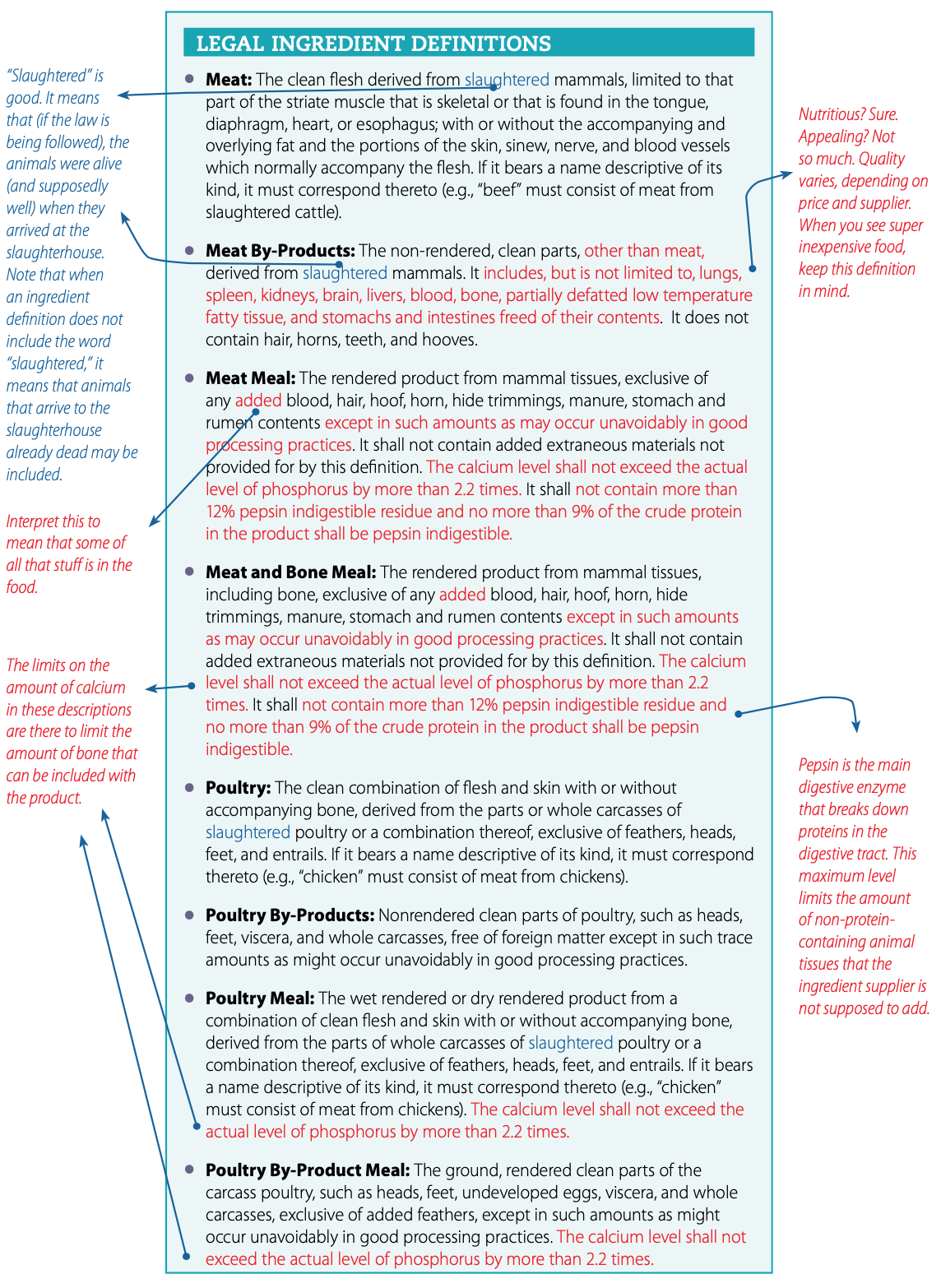A few years ago, we added a new column to the chart full of information that we publish in our annual “approved dry dog foods” list in the February issue. The column tabulates how many dog foods made by each company on the list were made with meat only, meat meal only, and/or a combination of meat and meat meal.
These tabulations do not constitute a judgment about the products listed; they are simply information for dog owners who understand the differences between the terms and the inferences that one can make from that information. But it has come to our attention that many of you aren’t aware of what, exactly, you can infer about a pet food company – or an individual product – from its inclusion of meat, meal, or both on its ingredients panel. So let’s clear this up!

NAMING AND SHAMING
First, though, you need to understand that, for the purposes of this article, when we use the generic phrases “meat” and “meat meal,” we are discussing named meats: chicken and chicken meal, pork and pork meal, beef and beef meal, etc. We don’t include any products on our “approved foods” lists that utilize unspecified protein sources on the ingredients label. When an unnamed animal protein source appears on the ingredients panel, the consumer has no idea of what mammal or type of poultry is in the can or bag.
To repeat: If you see one of the following phrases on the ingredients list of a dog food, you won’t see that dog food on our “approved foods” lists: meat, meat by-products, meat meal, meat and bone meal, poultry, poultry by-products, poultry meal, poultry by-products meal.
Each of these words or phrases have legal definitions when they appear on an ingredient panel. Lacking a word that indicates the species of animal has contributed the “meat” in question, the buyer has no way of knowing what they might be feeding their dog. Is it beef? Lamb? Pork? Chicken? Whatever leftover animal protein source the manufacturer can buy on sale? There is no way to know.
MEATY ISSUES
What we are discussing here and now, though, is the difference between named meats and their named meat meal corollaries. What’s the difference between chicken and chicken meal, beef and beef meal, etc.?
There is a critical clock ticking when it comes to fresh and frozen meats and meat by-products. Refrigeration is costly – and doesn’t hold off degradation of the ingredients for long. Freezing preserves meats longer, but is several factors more costly than refrigeration. Companies that use fresh meats in their pet foods need to get those ingredients into their mixers and extruders quickly; the more time it takes to get from the meat-processing plant to the food-manufacturing plant, the costlier the ingredients become.
If the meat products are not refrigerated or frozen, their quality is heavily impacted by the time and distance it takes them to travel to either a rendering company or a pet food manufacturer. The longer it takes them to be cooked in one form or another, the more bacterial decay and enzymatic breakdown will occur, affecting the quality of the protein and fat.
Pet food makers need to test and control a slew of quality-indicator parameters to make sure the meat-based ingredients are of sufficient quality to be safe, nutritious, and palatable. The quality of the product can be determined by the color and smell of the material, as well as analytical values for protein, available lysine, total lysine, methionine, pepsin digestibility (higher values are equated with higher protein content), peroxide value (higher values mean greater rancidity of the fats), OSI value (indicates the oxidative stability of the fats), ash (more on that in a minute), level and type of amino acids they contain.
MAKE A MEAL OF IT
[post-sticky note-id=’457802′]Meat meals are made through a process called rendering. The process is named “rendering” as it renders volatile, degradable meats into a more stable form. The animal products are subjected to high temperatures, both in order to kill any pathogens and to drive a certain amount of moisture and fat away from the bone and tissue.
Once the product is in a lower-moisture form (around 10%), it will remain relatively stable at room temperatures for months. Meat meals can be shipped and stored for some time, until the pet food producer is ready to make some food.
For these reasons, the smaller the annual sales of a pet food brand and/or the less frequently a particular product will be made, the more likely it is that the product will be made with meat meals, rather than fresh meats. Meat meals made from exotic species that are in limited supply (perhaps only seasonally) are almost always supplied in the form of rendered meals.
Competent rendering companies can produce meat meals with a range of fat and “ash” content. Pet food companies stipulate how much fat and ash they will accept in the ingredients they buy from the renderer. In general, higher-fat ingredients will cost more than lower-fat ingredients. Lower-ash ingredients cost more than high-ash ingredients.
MEAT-ONLY FOODS
There are companies that have staked their entire reputations on the fact that they use only meats, never meat meals, in their dry dog foods. Is this truly a sign of higher quality?
Actually, there’s something to look out for in those “meat only” (meal-free) dry dog foods: the inclusion (and frequently, the over-representation) of plant-sourced proteins, which have a less desirable amino acid profile than meat (for dogs).
Remember, ingredients are listed on the label in order of pre-processing weight in the food’s formula. Meat contains about 70% moisture and is very heavy, so if it is included in a large enough quantity so as to appear first or second on the ingredient list, it can’t actually be supplying the majority of the product’s protein. This is because the meats that are used in pet food – which actually contain quite a bit of skin, fat, connective tissue, and bone – may contain as little as 8% protein.
In foods that contain both meat and meat meal high on the ingredients list, it’s the meat meal that supplies most of the protein in the product. If there is no meat meal in a dry dog food, it has to have some plant protein sources to boost the protein content to adequate levels. We couldn’t say, then, that we feel these meat-only dry dog food formulations are unequivocally better.

IMPOSSIBLE TO CONFIRM
We’re sorry to say it, but the factors that most affect the quality of the meat ingredients in dog foods are absolutely impossible to confirm. The source of the ingredients, whether they are kept chilled, the distance to the rendering plant or food-production facility, the amount of time it takes for those ingredients to be processed . . . none of these things are verifiable by consumers (or journalists, in case you were wondering).
Giant conglomerate food companies actually have an advantage here, in that many have rendering and/or pet food manufacturing facilities adjacent to their human food processing facilities, sparing the meat and meat by-products a long journey at the local air temperature.
That said, there must be smaller companies that have located their manufacturing facilities conveniently close to their animal-protein suppliers. And we know that some pet food makers do keep their meat ingredients chilled all the way between the slaughterhouse to their pet food mixing and extrusion or canning equipment. But these facts are difficult to verify and subject to change at a moment’s notice. Consumers (us included) are stuck with having to trust the reputation of the company and performance of the products themselves.






I am totally confused.. I am looking to switching to NurtiSource Large breed adult but the third or fourth ingredient is chicken meal and you state no poultry meal??? But it is on your approved list, what am I missing in your statements.
If you read carefully the “Naming and Shaming” section, it points out the difference between generic and named sources. That might help clear things up for you.
Donna, Chicken meal is good as it’s a named meal source vs Poultry meal is unnamed, could be from any bird.
I discount anything anybody says (particularly those claiming they are ‘experts’ in something) when I see writing in all caps. Looks like a 3 yr old wrote it.
I hope all dog owners take heed to this very informative article.
I have been preparing fresh ingredients dog food and freezing it for years after obtaining a degree in Canine Nutrition.
I choose to spend a little extra on fresh groceries each month than buying inferior extruded dog food which would ultimately result in more vet visits/ medications and shortening my dogs’ lives. A daily, half cup of prepared species-appropriate food is more beneficial than 2-3 cups of the highest-priced dog kibble. Once a dog’s diet is changed from kibble to “real” food, the owner will totally understand the term “crap in, crap out”…..as the fecal matter becomes minimal. My Toy Poodle’s daily excrement is just a tiny amount in the size of rabbit/deer pellets.
Cudos to you!i have also been practicing this for 20 years and studied with the infamous Australian veterinarian surgeon, Dr. Tom Lonsdale, who promotes the raw diet and animal nutrition. People need to beware of vets who automatically refute this diet without the vets quoting “proper” research and that doesn’t mean one article that fellow vets in their profession may possibly quote. Financial incentives to promote the kibble industry, especially vets who sell kibble, and the true health of the dog is completely misunderstood by them and they try to confuse the consumer who many don’t understand this nor has the proper research backround.
Hello! Can you share recipes or share the best website for recipes that are breed specific and optimal? I have 3 large dogs and we feed them ACANA and Orijen. Looking for alternatives.
Have you considered checking Vet recommended diets for dogs with medical problems. Tests show that my Papillon may produce calcium oxalate and struvite crystals which may lead to kidney and bladder stones. The food ingredients are: Brewer’s rice, corn, chicken fat, chicken by-product meal, brewer’s rice flour, corn gluten meal, natural flavors, salt, etc. Royal Canin, Urinary SO. I would love to use a raw diet or even cook for him, but I am terrified that I may not have the correct food to prevent the formation of these crystals. I don’t know how to find a diet appropriate for him. My Vet is of no help, she just says that she has had dogs live their whole lives on this brand diet.
So maybe your dog will never get crystals, but it may get something else from eating this less than superior food. If you are listing the ingredients in order than your food is predominately made of rice, corn & chicken fat. Would you eat that as a complete and nutritious diet and feel you will have optimal health?
I am curious how you test an individual dog for the propensity to have/ form crystals? It is interesting that Oxalite crystals are caused by to acidic of food and struvite by to alkaline. It seems unlikely a dog would have both unless they had liver or kidney disease or an infection as those can cause struvite crystal too. If your dog previously had crystals Wysong makes PH balancing probiotic supplement that could be put on any food, but you must know which type of crystals.
I am curious. Is your vet in a VCA hospital? They are owned by Mars Corporation and coincidentally so is Royal Canin. You can draw your own conclusions about whether this is a conflict of interest. I have heard there is a lot of pressure to “sell”. What I will says is if Eli Lilly, for instance, owned your doctors office would you feel at all that there was a conflict of interest when it came to perscribing medications? A raw diet produced by a reputable company should be balanced and least likely to cause a dietary problem. I can speak to Primal, Steve’s Real Meat , Stella & Chewy and Bravo as being respectable brands with longevity and proven history. You could create your own, but it is a lot of work and the margin for error is much higher. If you choose to do that, I would get Dr. Karen Becker’s book or Steve Brown’s.
The below is copy and pasted from Mars.
Mars Petcare
Our 50+ global brands include PEDIGREE®, Waltham Center for Pet Nutrition, WHISKAS®, ROYAL CANIN®, AniCura, WISDOM PANEL™ and VCA™.
Made by Mars | Mars, Inc. – Mars, Incorporated
I would like to see an article with a number of different fresh dog food recipes possibly in the form of various protein meat loaves with a variety of veggies etc. & healthy carbs. This may be a convenient way to feed your pets & healthier than dog foods. Need to have all the ingredients that dogs need to thrive. The article above seems to have a lot of repetition and could have used half the verbiage.
I HAVE A GOLDENDOODLE THAT WAS ON VICTOR GRAIN FREE FROM PUP TO 15 MONTHS, THEN VERUS CHICKEN RICE AND OATS. WITH ALL THE ISSUES AND WARNINGS ABOUT NUTRITIONAL DCM WITH GRAIN FREE AND BOUTIQUE DIETS I SWITCHED HER TO PURINA PRO PLAN SENSITIVE SKIN AND STOMACH SALMON AND RICE…SHE HAS A CHICKEN ALLERGY. I KNOW ITS NOT ON YOUR APPROVED LIST AND I FRETTED OVER FEEDING HER THIS, I HAVE NOT USED PURINA IAMS EUKANUBA IN OVER 15 YEARS. THE SAME THING WITH VETS, NO HELP WITH NUTRITION, SAME ANSWERS, HILLS SCIENCE DIET ETC,
i have a mixed breed dog that weighs around 70 to 80 lbs. she is slowly getting over pancreaitis and i can’t give any fatty things to eat. i am feeding her raynes low fat kangaroo dry dog food. seeing as i can’t give her anything fat do you think it would hurt if i gave her boiled egg whites? i know the egg whites don’t have a lot of fat. she isn’t herself yet when it comes to eating yet so i thought it would be a good coaxer by putting the egg whites in her dry food. if this is all right, would it be all right if i put one or two in with her food. i will be starting her on the occasional pain pill because she is having trouble with her back legs. would it be all right to take the yolk out of the egg and boil the egg white and put the pill in the egg white after being cooked to get her to take them , as she hates to take pills and she would swallow them whole,